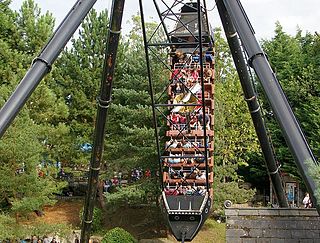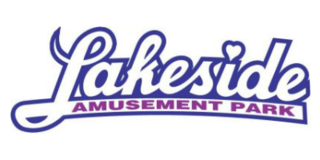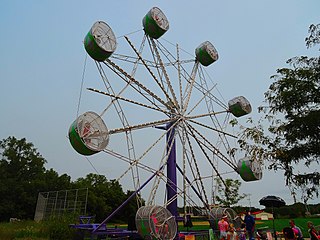Lee Ulrich Eyerly was an American civil aviation pioneer and amusement ride manufacturer. Eyerly helped found Salem Oregon's McNary Field, built the Flying E Ranch in Wickenburg, Arizona and invented several amusement park rides including the Loop-O-Plane, the Roll-O-Plane the Fly-O-Plane the Rock-O-Plane, and the Octopus.

A pirate ship is a type of amusement ride based on pirate ships, consisting of an open, seated gondola which swings back and forth, subjecting the rider to various levels of angular momentum. A variant where the riders must pull on ropes to swing the ride is known as a swing boat.

Lakeside Amusement Park is a family-owned amusement park in Lakeside, Colorado, adjacent to Denver. Opened in 1908, it is the oldest amusement park in Colorado still operating in its original location, and is the lone remaining American amusement park to have had the name White City. The park, comprising nearly half of the Town of Lakeside that it was responsible for creating in 1907, features the landmark Tower of Jewels.

Lake Winnepesaukah, commonly known as Lake Winnie, is an amusement park located in Rossville, Georgia, on the south of Chattanooga, Tennessee. Carl and Minette Dixon opened the park to over 5,000 guests on June 1, 1925. They named it after the Native American word Winnepesaukah, meaning "bountiful waters" or "beautiful lake of the highlands". The park originally featured the largest swimming pool in the southeastern United States, which debuted in 1926 and was later removed. Its Boat Chute attraction, designed by Carl Dixon and opened in 1927, is the oldest mill chute water ride of its kind still operating in the United States.
The Pretzel Amusement Ride Company was an amusement ride manufacturer that produced a variety of rides, including an early dark ride known as The Pretzel, the company's namesake. It built over 1400 rides for carnivals and amusement parks.

Seabreeze Amusement Park (Seabreeze) is a historic family amusement park located in Irondequoit, New York, a suburb of Rochester, where Irondequoit Bay meets Lake Ontario. According to the National Amusement Park Historical Association (NAPHA), Seabreeze is the fourth-oldest operating amusement park in the United States and the thirteenth-oldest operating amusement park in the world, having opened in 1879. The park features roller coasters, a variety of other rides, a midway, and a water park.

Elitch Gardens was a family-owned seasonal amusement park, theater, and botanic garden in the West Highland neighborhood in northwest Denver, Colorado, United States, at 38th Avenue and Tennyson Street. For more than a century Elitch's was one of the most popular entertainment destinations in Colorado. It was nationally known for its luscious gardens, the Elitch Theatre, the Trocadero Ballroom, and the premier wooden roller coaster, Mister Twister. The park moved to downtown Denver in 1994 and later in November 1998 became Six Flags Elitch Gardens. The former location has been redeveloped.
Lakeside Amusement Park was an amusement park located in Salem, Virginia, neighboring Roanoke, at the intersection of U.S. Route 460 and State Route 419. The park was named after a very large swimming pool which was opened on the site in 1920. The pool was surrounded by a beach and quickly became a favorite summer retreat for residents of Roanoke and Salem. Amusement park rides were added to the facility within a few years of its opening. The park also included a pavilion, which hosted celebrity concerts. Frequent performers included country artists Tom T. Hall and Conway Twitty.

Camden Park is a twenty-six acre amusement park located near Huntington, West Virginia. Established in 1903 as a picnic spot by the Camden Interstate Railway Company, it is one of only thirteen trolley parks that remain open in the United States. Whereas most trolley parks were located at the end of trolley lines, Camden Park is unusual in that it was built where riders traveling between Huntington and nearby cities would stop to change lines. Not long after opening, the park soon gained a carousel and other roadside attractions. Camden Park is West Virginia's only amusement park. The park is home to more than thirty rides and attractions, including a full-size traditional wooden roller coaster, the Big Dipper, and several other vintage rides.

The Monster is an amusement ride manufactured by Eyerly Aircraft Company. The ride spins while moving up and down at a slow pace. Each car spins while giant arms move up and down in a circular motion. Riders may experience the feeling of weightlessness when going in the air and coming back down to ground level.

The Octopus is a type of amusement ride in the shape of an octopus. Six to eight arms attached to a central axis of rotation and move up and down in a wavelike motion via a counter rotating eccentric, while cars at the end of the arms, either attached directly to the arm or fixed on spinning crosses, spin freely or stay in place, depending on the exact type of ride. Each Octopus ride has the arms attached the middle of the ride. The middle or centric of the ride will move somehow. Most octopus rides require guests to be at least 42 inches to ride without an adult; smaller children must have an adult with them. This is a regular at the annual AGS and AHS fairs in Ateneo de Manila University

The Scrambler, Twist, Twister, Cha Cha, Sizzler, or Merry Mixer, is an amusement ride in which suspended riders spinning in cars experience centrifugal force, while spinning along two separate axes. Riders are seated in small carriages clustered together and connected by beams at the top to a central point. The clustered vehicles are spun in one direction, while the ride as a whole spins in the opposite direction. There are a number of variations of the design.

A Ranger is an inverting pendulum ride first manufactured by HUSS Machinenfabrik in 1981. Many of the design elements were later used in the HUSS Rainbow, and the term 'Ranger' has become synonymous with inverting pendulum rides. It was the first inverting swing ride designed since Lee Eyerly's Loop-O-Plane and set the standard for many other attractions using the inverting pendulum ride system, such as the Rainbow, the Kamikaze (ride), and the Inverter.

The Rock-O-Plane is an amusement park ride designed by Lee Eyerly in 1948 and manufactured by the Eyerly Aircraft Company of Salem, Oregon.

Wildfire is a steel roller coaster located at Silver Dollar City in Branson, Missouri. Manufactured by Bolliger & Mabillard, the $14-million ride opened to the public on April 4, 2001. It is themed as a flying machine developed by a fictional 1880s Ozark inventor.
Castle Park, formerly Castle Amusement Park, is a 25-acre amusement park and family amusement center located in Riverside, California. The park utilizes a medieval "castle" theme and includes attractions such as a miniature golf course, arcade, and 21 amusement rides including one roller coaster, Merlin's Revenge, a junior rollercoaster. The main "castle" themed building, houses the arcade. The park was designed, built and operated by Bud Hurlbut, who designed several rides at Knott's Berry Farm. Castle Park is currently owned and operated by Palace Entertainment.

The Roll-O-Plane, also known as the Bullet is an amusement park ride that originated in America. It was invented by the Eyerly Aircraft Company of Salem, Oregon, as an updated and more exciting version of the Loop-O-Plane. The ride is commonly nicknamed the "Salt and Pepper Shakers".
Frank Hrubetz & Co., Inc. was an American manufacturer of amusement park flat rides. Established in 1939, the company was located near the Salem, Oregon airport. It sold both trailer-mounted and permanent model rides to theme parks throughout the world. Models included the Meteor, Paratrooper, Round Up, and Tip Top. In 1968, the company's estimated business brought in over $1.5 million and its plant space was 25,000 square feet. By the early 1970s, Hrubetz was selling 60 rides each year, making it the second largest manufacturer of amusement rides in the United States. They closed their manufacturing doors in 1992.
Eyerly Aircraft Company was an amusement ride manufacturing company in Salem, Oregon, founded by Lee Eyerly in 1930. The company originally intended to design flight simulators for the aircraft industry but shifted to amusement rides after an early simulator, called Orientator, became a popular pay-per-ride attraction with the public. The company manufactured rides until 1985 and went bankrupt in 1990, following a fatal accident in 1988 on a ride built by the company.














